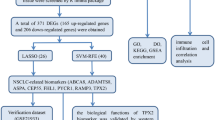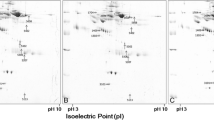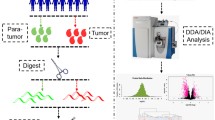Abstract
No biomarker has been available to detect early lung cancer so far. The aim of this study is to screen biomarker patterns for early diagnosis of non-small cell lung cancer (NSCLC) using laser capture microdissection (LCM) and surface-enhanced laser desorption ionization time-of-flight mass spectrometry (SELDI-TOF-MS). The 3 groups of the interested cells from 13 NSCLC tissues, 11 normal lung tissues (out of the 13 NSCLC patients), and 6 benign lung diseased tissues (BLD) were successfully separated by LCM, respectively, and the homogeneities of each type of the cell populations in the three groups were estimated to be over 95%. One-hundred- and twenty-three M/Z peaks were found in the NSCLCs and normal lungs, and between the two groups the relative intensity of 98 M/Z peaks was significantly different (P < 0.05) using SELDI-TOF-MS. The diagnostic pattern constructed using support vector machine (SVM) including three proteins, M/Z 4282, 3201, and 4252 Da, respectively, showed maximum Youden Index (YI). The pattern was validated by leave-one-out cross validation (LOOCV) and the results showed that the sensitivity was 100.0%, specificity 90.9%, and positive predictive value (PPV) 92.9%. In the NSCLCs and BLDs 188 M/Z peaks were determined and 54 showed statistically difference (P < 0.05). The sensitivity, specificity, and PPV of the diagnostic pattern consisting of two proteins, M/Z 3204 and 3701 Da, were all 100.0%. So, by using LCM we have successfully purified the interested cells and solved the problem of heterogeneity of lung cancer tissue. SELDI protein chip coupled with SVM could effectively screen the differentially expressional protein profiles and eventually establish biomarker patterns with high sensitivity and specificity.



Similar content being viewed by others
References
Yang DC, Yang SY. The current status and progress of lung cancer diagnosis. Chin J Tuberc Respir Dis 2004;27:18–9.
Granville CA, Dennis PA. An overview of lung cancer genomics and proteomics. Am J Respir Cell Mol Biol 2005;32:169–76.
Zhong L et al. Identification of circulating antibodies to tumor-associated proteins for combined use as markers of non-small cell lung cancer. Proteomics 2004;4:1216–25.
Alfonso P et al. Proteomic analysis of lung biopsies: differential protein expression profile between peritumoral and tumoral tissue. Proteomics 2004;4:442–7.
Bonner RF et al. Laser capture micro-dissection: molecular analysis of tissue. Science 1997;278:1481–3.
Swensen SJ et al. Lung cancer screening with CT: mayo clinic experience. Radiology 2003;226:756–61.
Liao P et al. Detection of serum protein biomarkers by surface-enhanced laser desorption and ionization time of flight mass spectrometry (SELDI-TOF-MS) in patients with lung adenocarcinoma. Bull Chin Cancer 2006;15(4):258–61.
Service RF. Genetics and medicine. Recruiting genes, proteins for a revolution in diagnostic. Science 2003;300:236–9.
Cazares LH et al. Normal, benign, preneoplastic and malignant prostate cells have distinct protein expression profiles resolved by surface enhanced laser desorption/ionization mass spectrometry. Clin Cancer Res 2002;8:2541–52.
Seibert V, Ebert MP, Buschmann T. Advance in clinical cancer proteomics: SELDI-TOF-mass spectrometry and biomarker discovery. Brief Funct Genomic Proteomic 2005;4:16–26.
Yang SY et al. Application of serum SELDI proteomic patterns in diagnosis of lung cancer. BMC Cancer 2005;5:83.
Emmert-Buck MR et al. Laser capture microdissection. Science 1996;274:998–1001.
Zhukov TA, Johanson RA, Cantor AB, Clark RA, Tockman MS. Discovery of distinct protein profiles specific for lung rumors and pre-malignant lung lesions by SELDI mass spectrometry. Lung Cancer 2003;40:267–79.
Byvatov E, Schneider G. Support vector machine applications in bioinformatics. Appl Bioinformatics 2003;2:67–77.
Jorissen RN, Gilson MK. Virtual screening of molecular databases using a support vector machine. Chem Info Model 2005;45:549–61.
Wang JX et al. Application of serum protein fingerprint in diagnosis of papillary thyroid carcinoma. Proteomics 2006;6:5344–9.
Baker H et al. Proteome-wide analysis of head and neck squamous cell carcinomas using laser-capture microdissection and tandem mass spectrometry. Oral Oncol 2005;41:183–99.
Acknowledgments
This work was supported by grants from the National Natural Science Foundation of China (No. 30570795) and Program for New Century Excellent Talents in University (No. NCET06-0845) and the Key Program in Science and Technology of Shaanxi Province Shaanxi [No. 2007K09-01(3)].
Author information
Authors and Affiliations
Corresponding author
Rights and permissions
About this article
Cite this article
Yang, S., Nan, Y., Tian, Y. et al. Study of distinct protein profiles for early diagnosis of NSCLC using LCM and SELDI-TOF-MS. Med Oncol 25, 380–386 (2008). https://doi.org/10.1007/s12032-008-9050-6
Received:
Accepted:
Published:
Issue Date:
DOI: https://doi.org/10.1007/s12032-008-9050-6




